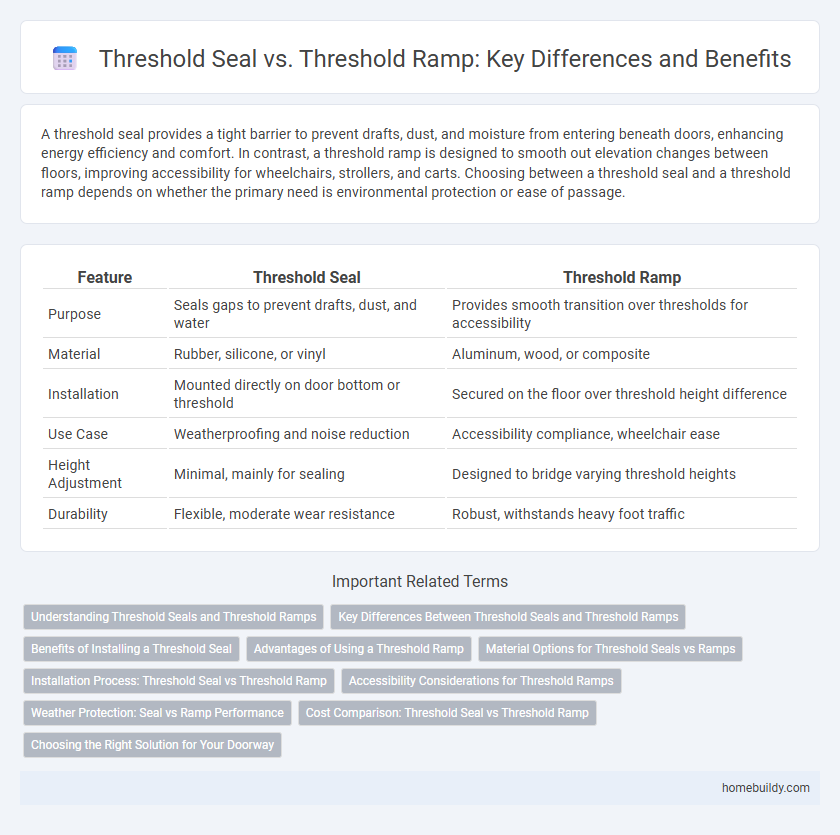A threshold seal provides a tight barrier to prevent drafts, dust, and moisture from entering beneath doors, enhancing energy efficiency and comfort. In contrast, a threshold ramp is designed to smooth out elevation changes between floors, improving accessibility for wheelchairs, strollers, and carts. Choosing between a threshold seal and a threshold ramp depends on whether the primary need is environmental protection or ease of passage.
Table of Comparison
| Feature | Threshold Seal | Threshold Ramp |
|---|---|---|
| Purpose | Seals gaps to prevent drafts, dust, and water | Provides smooth transition over thresholds for accessibility |
| Material | Rubber, silicone, or vinyl | Aluminum, wood, or composite |
| Installation | Mounted directly on door bottom or threshold | Secured on the floor over threshold height difference |
| Use Case | Weatherproofing and noise reduction | Accessibility compliance, wheelchair ease |
| Height Adjustment | Minimal, mainly for sealing | Designed to bridge varying threshold heights |
| Durability | Flexible, moderate wear resistance | Robust, withstands heavy foot traffic |
Understanding Threshold Seals and Threshold Ramps
Threshold seals provide an airtight or watertight barrier, enhancing energy efficiency and preventing moisture or drafts from entering a space through door gaps. Threshold ramps offer smooth, tapered transitions between floor surfaces at doorways, improving accessibility for wheelchairs, carts, and other wheeled devices. Choosing between a threshold seal and a threshold ramp depends on whether the priority is sealing performance or ease of access.
Key Differences Between Threshold Seals and Threshold Ramps
Threshold seals are designed to fill gaps between door bottoms and floors, preventing drafts, dust, and moisture infiltration, while threshold ramps provide a sloped transition to improve accessibility by bridging height differences between floor surfaces. Seals typically consist of flexible materials like rubber or vinyl for sealing purposes, whereas ramps are constructed from durable metals or composites to support weight and facilitate smooth movement over thresholds. The primary difference lies in their functional focus--threshold seals aim to enhance insulation and weatherproofing, whereas threshold ramps prioritize accessibility and safety.
Benefits of Installing a Threshold Seal
Installing a threshold seal enhances energy efficiency by preventing drafts, reducing heat loss, and improving indoor comfort. It also acts as a barrier against moisture, dust, and pests, contributing to a cleaner and healthier living environment. This simple addition extends the lifespan of doors by cushioning impacts and reducing wear and tear.
Advantages of Using a Threshold Ramp
A threshold ramp offers improved accessibility by providing a smooth transition over door thresholds, which is essential for wheelchair users and individuals with limited mobility. Unlike threshold seals that primarily block drafts and moisture, threshold ramps prevent tripping hazards and facilitate easier movement of wheeled devices. The installation of a threshold ramp enhances safety and complies with ADA standards, making it a practical solution for both residential and commercial entryways.
Material Options for Threshold Seals vs Ramps
Threshold seals are typically crafted from flexible materials such as rubber, silicone, or EPDM to provide airtight and weatherproof sealing. Threshold ramps, on the other hand, are commonly made from durable materials like aluminum, wood, or heavy-duty plastic to support weight and ensure smooth transitions between floor levels. Choosing the appropriate material depends on the specific application requirements, including durability, weather resistance, and load-bearing capacity.
Installation Process: Threshold Seal vs Threshold Ramp
The installation process of a threshold seal involves cleaning the doorway surface, measuring for an exact fit, and securing the seal with adhesive or screws to prevent drafts and water intrusion. In contrast, installing a threshold ramp requires leveling the doorway area, anchoring the ramp with bolts or screws, and ensuring a smooth transition for wheelchair accessibility. Proper alignment and surface preparation are crucial in both installations to ensure durability and functionality.
Accessibility Considerations for Threshold Ramps
Threshold ramps are designed to improve accessibility by bridging height differences at doorways, making entry easier for wheelchair users and individuals with mobility aids. Unlike threshold seals, which primarily focus on sealing gaps to prevent drafts and water intrusion, threshold ramps prioritize smooth, gradual transitions to comply with ADA standards. Accessibility considerations include appropriate slope ratios, non-slip surfaces, and secure placement to ensure safety and usability for all individuals.
Weather Protection: Seal vs Ramp Performance
Threshold seals provide superior weather protection by creating a tight barrier that prevents drafts, moisture, and dust infiltration, ensuring enhanced insulation and energy efficiency. Threshold ramps primarily facilitate smooth transition across doorways but offer limited resistance to water and air penetration compared to seals. Effective weatherproofing is best achieved with threshold seals, while ramps prioritize accessibility over protection.
Cost Comparison: Threshold Seal vs Threshold Ramp
Threshold seals typically cost less than threshold ramps due to simpler materials and installation requirements, with average prices ranging from $10 to $30. Threshold ramps, designed for accessibility and smooth transitions, often incur higher costs between $50 and $150, reflecting additional materials and complexity. Budget considerations must account for these differences alongside functional needs to optimize investment.
Choosing the Right Solution for Your Doorway
Threshold seals provide a tight, weatherproof barrier ideal for preventing drafts, moisture, and dust from entering through doorways, enhancing energy efficiency and indoor comfort. Threshold ramps, designed for accessibility, offer a gradual incline suitable for wheelchairs, strollers, and carts, ensuring safe and easy passage across door thresholds. Selecting the right solution depends on your primary need: choose a threshold seal for insulation and protection, or a threshold ramp to improve accessibility and comply with ADA standards.
Threshold Seal vs Threshold Ramp Infographic

 homebuildy.com
homebuildy.com